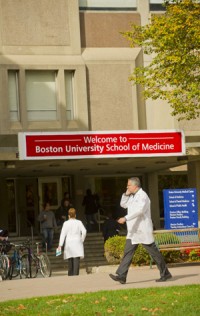MED Grapples with Major Sequestration Cuts
Centers bracing for cuts, layoffs as NIH budget slashed

No one knows the ultimate toll that federal sequestration will take on the Boston University Medical Campus. But its research centers have already seen cuts of up to 100 percent for fiscal 2013, necessitating layoffs and a renewed, urgent push to secure nongovernment funding sources.
Research funding for the School of Medicine has fallen 16 percent from last year, says Karen Antman, MED dean and provost of the Medical Campus and the John Sandson Professor of Health Sciences. Virtually all of the drop is in funding for centers. “Big center grants are being hit hardest,” Antman says. And a conversation with MED researchers makes it clear the cuts are having a large ripple effect already.
The National Institutes of Health (NIH) “is making the right choices given the terrible position the Congress put them and us in, but it’s awful for researchers and for the country,” says Joseph P. Mizgerd, a MED professor of medicine, microbiology, and biochemistry and director of the Pulmonary Center. Mizgerd says the NIH’s National Heart, Lung and Blood Institute (NHLBI) did not renew funding for a multiproject lung development center grant, now in its 20th year, a decision being appealed by principal investigator Wellington Cardoso, a MED professor of medicine and pathology. Sequestration “is only the latest event in a decade of fading congressional support for biomedical research,” Mizgerd says.
David Atkinson, who lost federal funding for a 30-year multiproject center grant of cell biology and cardiovascular disease, says NIH cutbacks in the number of grants “puts people’s livelihoods in jeopardy. It impacts students halfway through their PhD research projects.” Atkinson’s ongoing, NHLBI-funded study had been receiving nearly $1.3 million a year, a grant that supported a staff of 30. “I’ve been here 38 years, and we went through a bad period in the 1980s, but it has never been this bad,” he says. The sequestration cuts are being felt acutely by graduate students. “I can’t recruit PhD students,” he says. “Science is in danger of losing a whole generation because the positions are no longer there.” Like his colleagues, Atkinson is looking for bridge funding and other means of support to continue his work “by hook or by crook.”
Although the NIH budget was cut 5 percent, MED faculty have been told to assume a 10 percent budget reduction, according to Antman. Faculty are on notice that they must carefully monitor spending on staff, supplies, and travel in this “time of uncertainty,” when most federal funding agencies face deep cuts. The NIH is the largest sponsor of medical research, and its cuts translate to an estimated $1.5 billion nationwide.
“We are already used to being lean and efficient,” says Antman. “All health science campuses are subject to these NIH cuts. How we manage them will determine if we remain competitive.” She says that MED’s “relative lack of endowed chairs make it more difficult to recruit in competition with institutions with larger endowments.” For now, the school is hiring only research faculty who already have grants in place. “For new grants, faculty need to write more proposals to be funded at the same rate,” Antman says.
“It’s a very unfortunate situation,” says Gloria Waters, recently named vice president and associate provost for research for both the Charles River and the Medical Campus. Waters cited the recent 40 percent reduction in funding for the ongoing Framingham Heart Study, one of the world’s largest and longest-running epidemiological studies, begun in 1948 by the NIH and run by Boston University since 1971. Those cuts will result in 19 layoffs of clinical and administrative staff beginning November 1, Antman says.
Despite the sequestration cuts, the Medical Campus is “still recruiting some fabulous faculty members,” Waters says, and the amount of research continues to increase as MED hires research-active faculty to replace retiring faculty less actively engaged in research.
On its sequestration fact sheet, the NIH, the world’s leading supporter of biomedical research, estimates that federally mandated cuts will translate to 700 fewer research grants to institutions compared to the previous year. On August 1, University President Robert A. Brown was among 186 university leaders to sign an open letter, published in the print edition of Politico, calling for a restoration of federal funding for research and warning of a coming “innovation deficit” if funding cuts persist. In 2011, with nearly $132 million in grants, BU’s Medical Campus ranked 47th of approximately 2,600 organizations receiving NIH funding for research. NIH-funded research is the foundation of a medical innovation sector that employs one million US citizens.
“There really is no replacement for this money, so basically faculty are needing to figure out how to carry out work on smaller budgets,” says Waters. “For some it can mean taking a technician off a grant; others may need to let several people in their lab go.”
Most at risk is basic research, the high-risk projects that ask fundamental questions without any attempt to “artificially infuse the research with clinically oriented questions,” says Darrell Kotton, a MED professor of medicine and pathology and director of the Center for Regenerative Medicine (CReM). “Sequestration comes on the heels of the downturn of availability of funding, so investigators are already low on their reserves.” Kotton predicts that if basic research cuts persist, “scientists will tend to be a little less adventurous and more risk-averse. That’s a paradigm shift,” and the “real exciting science” will suffer—something Kotton says the next generation will pay for.
This BU Today story was written by Susan Seligson.